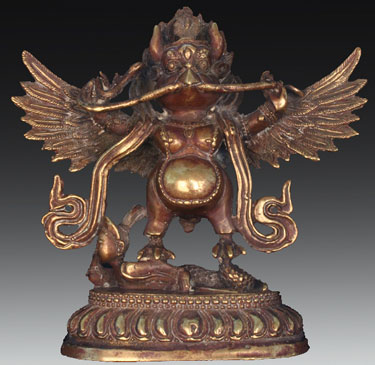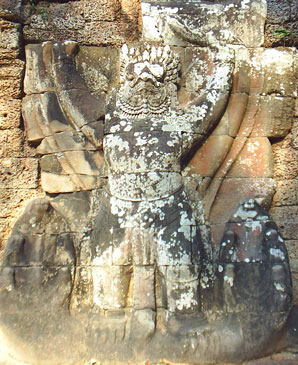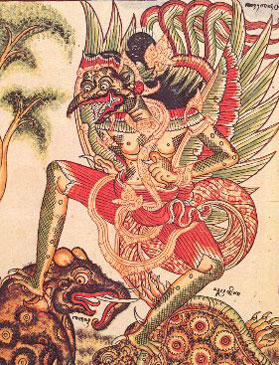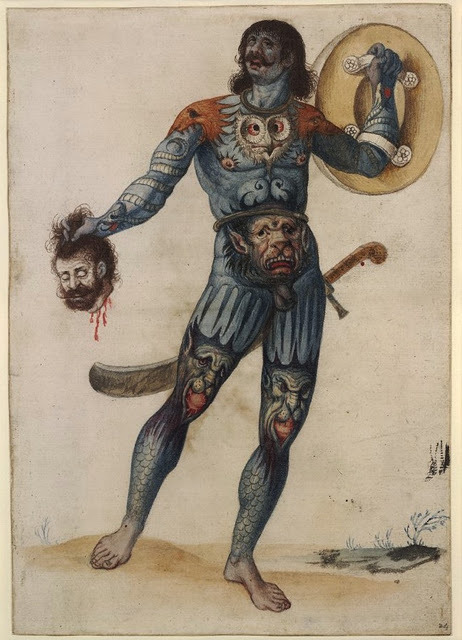Duncan Catalogue entry - Antiquities 502 An African idol. In page 46 of Herbert's Travels is a print representing this idol on an altar with fruit before him, at a little distance an Indian merchant or banyan pointing at him (Dr Rawlinson, St John's Coll.
List of Anthropological objects transferred from the Ashmolean to the Pitt Rivers' museum 1886. Asiatic, African, Esquimaux and American. [Vellum volumes] Volume I: 212. A wooden figure of an Indian idol or devil, on a stand having a hollow dome-shaped back. A very correct representation of this figure appears in page 37 of the "Travels of Sir Thomas Herbert", London, 1634. It is at the head of "a description of the Bannyans of Indya". The plate exhibits "An Indyan Merchant or Bannyan". who is pointing to the figure, before which is a dish of fruit, and above it, on the framework, is a small vessel containing fire. No direct allusion is made to the figure, or the merchant, but in reference to the inhabitants it is stated, that "they worship the Devill in sundry shapes and representations." The figure has a conical shaped hat from which, and the back of the head there have been sixteen spikes [Insert] inclined [end insert] outwards and more or less upwards, about half of them are left, and some of those in a broken condition. In the plate the figure is represented with four horns, which spring from beneath the cap, two on each side the front of the head; these are large and twisted like ropes, the two lower ones incline downward and outward, the two upper turn upward and outward: the figure has but one of these horns remaining and that imperfect. The face is very ugly but still human, except that the beard forms seven distinct rays. The arms and body are those of a woman, with large pendant breasts; the thighs, legs and feet appear to be intended to represent those of an Eagle. Over the region of the pelvis the figure holds the head of an animal, having two large ox-like horns, and large open mouth. One of the horns and the lip of the other have been lost. The whole is coloured black, except the eyes lips and beard of the figure, the eyes and mouth of the head below, and the hollow back of the stand, all of which are red. It appears to have had a tail which is also gone. Height of figure 15 8/10 inches; on stand 20 inches. Given by Dr Rawlinson, St: John's College, 1719 (Printed catalogue, 1836. p. 147 No. 502)
Additional entry in Vellum volume I - 212 Printed number agreeing with printed catalogue of 1836
Additional entry in Vellum volume I - Trans to Anthrop Mus March 11th 1886 (212)
Stuck in vellum volume [before page 4 of volume I] - Trans. from Ashmolean to Anthrop. Museum March 11th 1886 Section 9 Received the above [listed] HN Moseley March 12 1886
Ashmolean Accession book entry - Objects transferred from the Ashmolean Museum to the Pitt Rivers Museum in 1886 or later: 212. ?India. Black red-touched bird-legged bearded female-breasted figure with rayed conical hat, horns, and lion head in pelvis. Figured in Travels of Sir Thomas Herbert in 1634, page 37, with an Indian merchant. Dr Rawlinson, St John's College, 1719
Added Accession Book Entry - [typed piece of paper stuck onto opposite page of accession book] 'A.M. 212. A very correct representation of this figure appears in page 37 of the Travels of Sir Thomas Herbert, London, 1634. It is at the head of "a description of the Bannyans of Indya". The plate exhibits "An Indyan Merchant or Bannyan" who is pointing to the figure, before which is a dish of fruit and above it on the frame work is a small vessel containing fire. No direct allusion is made to the figure or the plate, but in reference to the inhabitants it is stated that "they worship the Devill in sundry shapes and representations". Presented by the Rev. Dr. Rawlinson, St John's Coll' [Added entry in pencil 268 (retrospective number)]
RDF - Notes and drawings in pencil of similar figures, some written on Radcliffe Library paper. These were found under the figure in the display case by Linda Mowat in February 1992 [AP 21/6/99]









